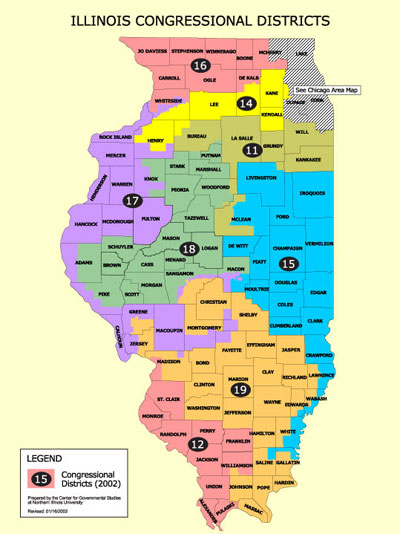I left the League of Women Voters meeting Saturday morning a little less hopeful than when I arrived. It’s not going to be easy to change minds in Springfield about the way the legislative districts are drawn. The meeting was dedicated to exploring ways we can make the districts contiguous and compact (as the Illinois Constitution demands), unlike they are now:

The suggested action plan, as proposed by former city councilman Bruce Brown, was to “let the sun shine in.” That may not sound like much, but the fact is that most people don’t realize just how ridiculous our districts are, and when they see them for the first time, they can hardly believe it. Brown mentioned that in Iowa, where their districts are now determined by an independent Legislative Support Bureau, agitation for change began with the Des Moines Register newspaper and some concerned citizens. He also cited the increased scrutiny congressional earmarks have been getting since that process was exposed. We need to get as many people and groups as possible to see the outrageousness of the current Illinois districts, and then get those people and groups to write their legislators demanding change. If enough constituents put pressure on them, legislators will respond.
Perhaps more difficult, but more importantly, we need to hold those legislators accountable. The reason these gerrymandered districts work, as Jim Thomas pointed out, is because our voting habits are so predictable. To have real change, we’re going to have stop rewarding gerrymandering politicians with our votes.
Another possibility, but one the League seemed loathe to attempt, is to vote for a constitutional convention for Illinois in 2008. The question of whether a constitutional convention should be called must appear on the ballot at least once every 20 years, according to the Illinois Constitution. The last time a constitutional convention was on the ballot was 1988, when it was soundly defeated (only 19% voted for it). The problem with a convention is that the whole Illinois Constitution is then up for grabs, and the League members fear that Illinoisans may lose more than they gain. Call it a healthy fear of the law of unintended consequences.
The legislative map is redrawn every ten years following the census, so the next scheduled redistricting will be voted on in 2011 and take effect in 2012. Unless anyone has a better idea, I say we get the word out and start putting as much pressure on our legislators as possible.
